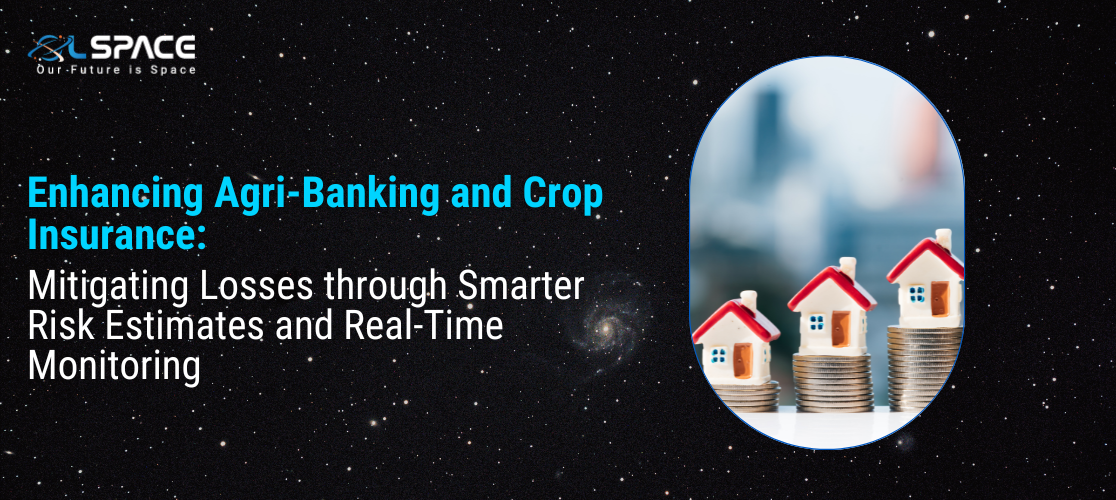02 June 2023
Enhancing Agri-Banking and Crop Insurance: Mitigating Losses through Smarter Risk Estimates and Real-Time Monitoring

Agriculture is a crucial sector that plays a vital role in food production and global economies. However, farmers face various risks, including unpredictable weather patterns, pests, diseases, and market fluctuations. To mitigate these risks and provide financial security, agri-banking and crop insurance systems have been established. In recent years, advancements in technology and data analytics have allowed for smarter risk estimates and real-time monitoring, enabling more effective risk management strategies. In this blog post, we will explore how enhancing agri-banking and crop insurance through these innovations can help mitigate losses and promote a sustainable agricultural sector.
Smarter Risk Estimates through Data Analytics Data analytics has revolutionised risk assessment in agriculture. By analysing historical and real-time data, including weather patterns, soil conditions, crop performance, and market trends, agri-banking and insurance institutions can make more accurate risk estimates. Advanced algorithms and machine learning techniques can identify patterns and correlations, enabling the identification of potential risks and vulnerabilities. This data-driven approach helps lenders and insurers offer appropriate financial products and coverage, tailored to the specific needs and risks of farmers.
Real-Time Monitoring and Early Warning Systems Real-time monitoring systems provide valuable insights into crop health, weather conditions, and other factors that impact agricultural productivity. Through the use of sensors, satellite imagery, and drones, agri-banking and insurance institutions can monitor crop growth, detect anomalies, and identify potential risks in real-time. Early warning systems can alert farmers, lenders, and insurers about adverse conditions, such as droughts, pests, or diseases, allowing for prompt intervention and risk mitigation. By leveraging technology for real-time monitoring, losses can be minimised, and farmers can receive timely support and financial assistance.
Precision Agriculture and Risk Management Precision agriculture techniques, including remote sensing, GPS technology, and variable rate technology, offer farmers a more targeted and efficient approach to managing risks. By analysing data from various sources, farmers can make informed decisions about irrigation, fertilisation, pest control, and other agronomic practices. Agri-banking and insurance institutions can leverage this data to assess the risk profiles of farmers and customise financial products and insurance coverage accordingly. Precision agriculture not only enhances productivity but also reduces input costs and potential losses, ultimately benefiting both farmers and lenders/insurers.
Climate Risk Modeling and Adaptation Strategies Climate change poses significant challenges to agriculture, with increased frequency and severity of extreme weather events. Agri-banking and insurance institutions are incorporating climate risk modeling into their risk management frameworks. These models simulate the potential impact of climate change on crop yields, production systems, and financial losses. By understanding these risks, lenders and insurers can encourage farmers to adopt climate-smart agricultural practices and implement adaptation strategies. This proactive approach helps farmers build resilience, minimise losses, and secure financial support when adverse weather events occur.
Financial Inclusion and Capacity Building Enhancing agri-banking and crop insurance also involves addressing issues of financial inclusion and capacity building. Access to credit and insurance services is crucial for smallholder farmers who often face barriers due to lack of collateral or financial literacy. Agri-banking institutions can employ innovative lending models, such as group-based lending or mobile banking, to reach underserved farmers. Similarly, insurance institutions can offer simplified products and promote awareness programs to improve farmers’ understanding of insurance coverage and its benefits. By increasing financial inclusion and building farmers’ capacity, the agricultural sector can become more resilient and sustainable.
Conclusion
By embracing smarter risk estimates, real-time monitoring, and incorporating technology-driven solutions, agri-banking and crop insurance systems can effectively mitigate losses and promote a sustainable agricultural sector. Data analytics, precision agriculture, early warning systems, and climate risk modeling enable lenders and insurers to assess risks accurately and provide tailored financial products and coverage. Additionally, fostering financial inclusion and capacity building ensures that farmers have access to vital services. By combining these advancements, we can create a resilient agricultural sector that safeguards farmers’ livelihoods and supports global food security.
Join our community and never miss an update! Subscribe to our newsletter and blog to stay up-to-date on the latest trends, tips, and insights in your area of interest. Don’t miss out on exclusive content and promotions. Sign up now and be a part of our growing community!
